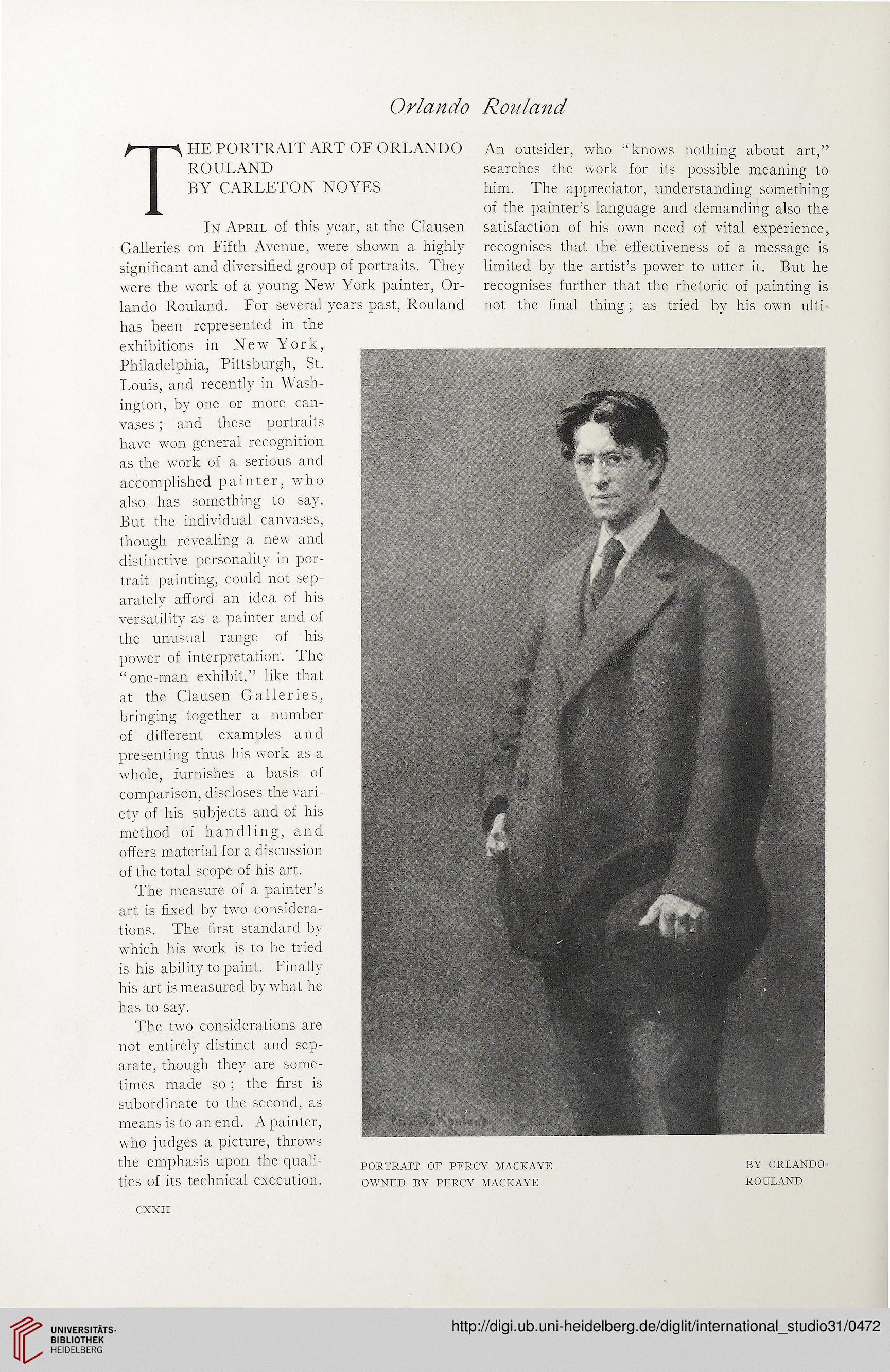Orlando Rouland
The portrait art of orlando
ROULAND
BY CARLETON NOYES
In April of this year, at the Clausen
Galleries on Fifth Avenue, were shown a highly
significant and diversified group of portraits. They
were the work of a young New York painter, Or-
lando Rouland. For several years past, Rouland
has been represented in the
exhibitions in New York,
Philadelphia, Pittsburgh, St.
Louis, and recently in Wash-
ington, by one or more can-
vases ; and these portraits
have won general recognition
as the work of a serious and
accomplished painter, who
also has something to say.
But the individual canvases,
though revealing a new and
distinctive personality in por-
trait painting, could not sep-
arately afford an idea of his
versatility as a painter and of
the unusual range of his
power of interpretation. The
“one-man exhibit,” like that
at the Clausen Galleries,
bringing together a number
of different examples and
presenting thus his work as a
whole, furnishes a basis of
comparison, discloses the vari-
ety of his subjects and of his
method of handling, and
offers material for a discussion
of the total scope of his art.
The measure of a painter’s
art is fixed by two considera-
tions. The first standard by
which his work is to be tried
is his ability to paint. Finally
his art is measured by what he
has to say.
The two considerations are
not entirely distinct and sep-
arate, though they are some-
times made so ; the first is
subordinate to the second, as
means is to an end. A painter,
who judges a picture, throws
the emphasis upon the quali-
ties of its technical execution.
An outsider, who “knows nothing about art,”
searches the work for its possible meaning to
him. The appreciator, understanding something
of the painter’s language and demanding also the
satisfaction of his own need of vital experience,
recognises that the effectiveness of a message is
limited by the artist’s power to utter it. But he
recognises further that the rhetoric of painting is
not the final thing; as tried by his own ulti-
PORTRAIT OF PERCY MACKAYE BY ORLANDO•
OWNED BY PERCY MACKAYE ROULAND
CXXII
The portrait art of orlando
ROULAND
BY CARLETON NOYES
In April of this year, at the Clausen
Galleries on Fifth Avenue, were shown a highly
significant and diversified group of portraits. They
were the work of a young New York painter, Or-
lando Rouland. For several years past, Rouland
has been represented in the
exhibitions in New York,
Philadelphia, Pittsburgh, St.
Louis, and recently in Wash-
ington, by one or more can-
vases ; and these portraits
have won general recognition
as the work of a serious and
accomplished painter, who
also has something to say.
But the individual canvases,
though revealing a new and
distinctive personality in por-
trait painting, could not sep-
arately afford an idea of his
versatility as a painter and of
the unusual range of his
power of interpretation. The
“one-man exhibit,” like that
at the Clausen Galleries,
bringing together a number
of different examples and
presenting thus his work as a
whole, furnishes a basis of
comparison, discloses the vari-
ety of his subjects and of his
method of handling, and
offers material for a discussion
of the total scope of his art.
The measure of a painter’s
art is fixed by two considera-
tions. The first standard by
which his work is to be tried
is his ability to paint. Finally
his art is measured by what he
has to say.
The two considerations are
not entirely distinct and sep-
arate, though they are some-
times made so ; the first is
subordinate to the second, as
means is to an end. A painter,
who judges a picture, throws
the emphasis upon the quali-
ties of its technical execution.
An outsider, who “knows nothing about art,”
searches the work for its possible meaning to
him. The appreciator, understanding something
of the painter’s language and demanding also the
satisfaction of his own need of vital experience,
recognises that the effectiveness of a message is
limited by the artist’s power to utter it. But he
recognises further that the rhetoric of painting is
not the final thing; as tried by his own ulti-
PORTRAIT OF PERCY MACKAYE BY ORLANDO•
OWNED BY PERCY MACKAYE ROULAND
CXXII




